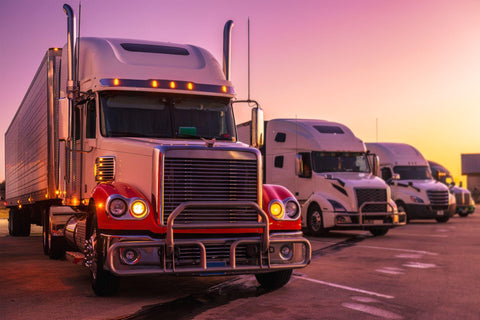
In today’s global economy, the trucking industry stands as a critical backbone, facilitating the transportation of goods across vast distances and borders.
This industry, characterized by its significant impact on logistics and supply chain efficiency, faces many challenges that include fluctuating fuel costs, the need for increased efficiency, stringent safety regulations, and the imperative to meet environmental standards.
Amid these challenges, Artificial Intelligence (AI) emerges not just as a technological advancement but as a transformative solution, poised to redefine the operational landscapes of trucking companies worldwide.
Background of AI in Trucking
Artificial Intelligence, or AI, refers to the simulation of human intelligence in machines that are programmed to think like humans and mimic their actions. In the context of trucking operations, AI represents a suite of technologies capable of processing vast amounts of data to make predictive decisions, enhance efficiency, and improve safety measures.
The journey of technology in trucking, from the introduction of GPS navigation to the adoption of electronic logging devices (ELDs), has set the stage for AI’s pivotal role in the industry. Today, AI is at the forefront of an evolutionary leap in trucking, offering solutions that not only streamline operations but also significantly reduce costs and environmental impact.
Optimizing Logistics and Route Planning
One of the most immediate benefits of AI in trucking is its ability to optimize logistics and route planning. Traditional route planning relied heavily on static variables and often couldn’t account for real-time conditions like traffic patterns and weather changes. AI algorithms, however, digest and analyze real-time data, historical traffic patterns, and weather forecasts to suggest the most efficient routes possible.
This dynamic route planning not only ensures timely deliveries but also contributes to significant fuel savings and reduced carbon emissions. A notable example of this innovation in action is the use of AI by major logistics companies to reroute fleets in real-time during unexpected weather events, ensuring both safety and adherence to delivery schedules.
Enhancing Safety and Compliance
Safety remains a paramount concern in the trucking industry, given the potential for accidents and the heavy regulatory environment. AI technologies are making strides in enhancing safety and compliance through various innovative approaches. Predictive analytics, for instance, play a crucial role in vehicle maintenance, allowing companies to address potential mechanical failures before they lead to downtime or accidents.
AI-driven safety features such as advanced driver-assistance systems (ADAS) include collision avoidance mechanisms and lane-keeping assists, significantly reducing the risk of human error on the road.
Furthermore, AI facilitates compliance with regulatory requirements by monitoring driver behaviors and ensuring adherence to rules such as the Hours of Service (HOS) regulations. Statistics from industry studies illustrate a decline in accident rates and safety incidents among fleets that have integrated AI technologies, underscoring the profound impact of AI on improving safety standards in trucking.
Improving Load Matching and Freight Brokering

The trucking industry’s efficiency is not solely dependent on the vehicles’ movement but also on how effectively these vehicles are utilized. AI significantly improves load matching—the process of aligning trucking capacity with freight needs—thereby enhancing operational efficiency. Through sophisticated algorithms, AI analyzes various factors such as location, cargo type, and delivery windows to optimize matches between carriers and shippers.
This precision reduces empty miles, maximizing revenue for truckers and reducing costs for shippers. Additionally, AI-powered platforms have revolutionized freight brokering, introducing dynamic pricing models that adapt in real-time to supply and demand fluctuations.
An example of AI’s impact can be seen in digital freight matching platforms, which have streamlined the brokerage process, making it faster, more efficient, and transparent for all parties involved.
Predictive Maintenance and Fleet Management
Predictive maintenance stands out as one of AI’s most impactful applications in trucking, offering the ability to foresee and prevent vehicle breakdowns before they occur. By analyzing data from various sensors installed in trucks, AI can predict mechanical failures, allowing for proactive maintenance and significantly reducing unscheduled downtime. This capability not only saves costs but also improves the overall efficiency and lifespan of the fleet.
AI’s role extends to comprehensive fleet management, where it assists in monitoring fuel consumption, tracking vehicles in real-time, and analyzing utilization patterns to enhance operational efficiency. Companies leveraging AI in fleet management have reported substantial savings and improved fleet reliability, highlighting AI’s role as a cornerstone of modern trucking operations.
Challenges and Limitations of AI in Trucking
While AI presents a transformative potential for the trucking industry, it also brings forth a set of challenges and limitations that must be navigated carefully:
- Data Privacy and Security: Implementing AI in trucking raises concerns about the confidentiality and security of the data collected, necessitating robust protection measures.
- High Implementation Costs: The initial investment in AI technology can be substantial, potentially deterring small to medium-sized enterprises.
- Technological Complexity: The complexity of AI trucking systems requires skilled personnel for operation and maintenance, leading to challenges in adoption and integration.
- Resistance to Change: There can be resistance from employees and management, stemming from fears of job displacement or mistrust in automated systems.
- Regulatory and Ethical Concerns: Navigating the regulatory landscape and addressing ethical issues related to automation and data usage pose significant challenges.
- Reliability and Dependence: Over-reliance on AI systems without adequate fail-safes can lead to vulnerabilities, especially in critical decision-making processes.
The Future of AI in Trucking
The horizon for AI in trucking extends far beyond current applications, promising even greater transformations as the technology evolves. Future developments could include the widespread adoption of fully autonomous trucks, which would revolutionize logistics by optimizing delivery times, reducing labor costs, and enhancing safety.
Moreover, AI trucking is expected to play a critical role in achieving sustainability goals through the development of eco-friendly routing algorithms and the integration of electric vehicles into fleets. Ongoing research into AI and machine learning continues to unveil new potentials for improving accuracy in predictive analytics, real-time decision-making, and personalized customer experiences.
As societal acceptance grows and regulatory frameworks evolve to accommodate these advancements, the trucking industry stands on the brink of a new era, shaped by the innovative applications of AI.
Drive into the Future with Suburban Seating & Safety
In an industry rapidly being reshaped by the advances of Artificial Intelligence, staying ahead of the technological curve is crucial. Suburban Seating & Safety stands at the forefront of integrating cutting-edge technology into the trucking sector, ensuring that our clients are equipped with the most innovative solutions available.
Our selection of semi-truck seats and safety accessories is designed to meet the evolving needs of modern truckers, blending comfort with technology to enhance both safety and efficiency on the road.
Embrace the future of trucking with Suburban Seating & Safety, where we don’t just follow the trends—we set them. Join us in navigating the path toward a smarter, safer, and more sustainable trucking industry.

